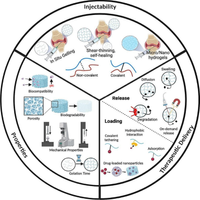Injectable hydrogels – Advanced material for filling the gap in osteoarthritis
University of Twente
Thanh Le
The ‘gap’ in Osteoarthritis!
Osteoarthritis (OA) is a debilitating joint disease characterized by articular cartilage degradation. Generally, articular cartilage is firm and smooth viscoelastic padding that covers bone ends at the joints to protect the bones and ensure smooth, frictionless, and pain-free movement. [1] In OA, cartilage fails to protect the bone ends, causing them to scrape against each other, which leads to pain, stiffness, decreased mobility, and even joint disability in some severe cases. One of the challenges in treating OA is that cartilage has a minimal capacity for self-repair due to the lack of a vascular system and the low mitotic activity of chondrocytes. Current treatments for OA can either reduce symptoms of OA such as physical therapy and medications, or completely remove the damaged cartilage using surgery, but still cannot reverse the disease. [1,2]
How can hydrogels fill in the degenerated cartilage gap?
Hydrogels are highly absorbent polymer networks that can retain a significant amount of water while maintaining their structural integrity. These jelly-like materials form a three-dimensional matrix that can mimic the properties of human tissue. Hydrogels can be engineered to respond or crosslink due to various stimuli such as temperature, pH, or enzymatic activity. Injectable hydrogels are a specialized form of hydrogel that can be administered into the body through minimally invasive injection techniques. These hydrogels are initially in a liquid or semi-liquid state, allowing them to be easily injected through a syringe. Once inside the body, they solidify into a gel-like structure at the target site – cartilage in our case – allowing them to fill irregular gaps and conform precisely to the shape of the damaged cartilage, providing a supportive scaffold that aids in the restoration of joint function. Furthermore, hydrogels can encapsulate therapeutic agents, such as drugs, growth factors, or cells, allowing for localized and sustained delivery directly to the cartilage. [2]
Fig, Injectable hydrogels in cartilage regeneration. Adapted of A. Atwal, et al. (2023). [2]
How can hydrogels be able to fill in the OA treatment ‘gap’?
• Minimally Invasive Procedure: Unlike surgical interventions that require extensive recovery periods, the injection of hydrogels is a minimally invasive procedure that can be performed on an outpatient basis. This not only reduces the risk of complications but also allows for quicker recovery and less downtime for patients. [3]
• Targeted Drug Delivery: Injectable hydrogels can be loaded with anti-inflammatory drugs, growth factors, and other therapeutic agents. This localized delivery ensures that high drug concentrations reach the affected area, reducing systemic side effects and enhancing therapeutic efficacy. [4]
• Cartilage Regeneration: The regenerative potential of hydrogels is one of the most exciting aspects of their application in OA. By incorporating stem cells or chondrocytes into the hydrogel matrix, these cells can be delivered directly to the site of cartilage damage. The hydrogel matrix mimics the extracellular matrix of cartilage, facilitating integration with native tissue and promoting cellular activities essential for regeneration.[5] Additionally, hydrogels can be loaded with growth factors like TGF-β, which stimulate chondrocyte proliferation and matrix production, further aiding in cartilage repair. [6]
Where are we in this research gap?
At the Developmental Bioengineering Group at UTwente, we have developed several natural hydrogels conjugated with tyramine groups (TA) such as Dextran-TA, Hyaluronic acid-TA, Chondroitin sulfate-TA, and Heparin-TA. These conjugated polymers enable controlled covalent crosslinking through enzyme-mediated reactions. We can tune the gelation time and crosslinking density – which corresponds to the rheological properties - of the hydrogels, making them suitable for intra-articular injection. Our injectable hydrogels have been proven to have promising results on in-vitro and in-vivo cartilage regeneration.
Currently, we are innovating our injectable hydrogel systems for controlled drug delivery by formulating hydrogel with several VHH antibodies that benefit cartilage regeneration. On the other hand, we are also working on adapting this system to the microenvironment in cartilage-on-chip, and fat pad-on-chip platforms to develop a joint-on-chip model for further OA study and drug screening.
Head to the future!
As research in this field advances, the horizon for personalized regenerative therapies expands, offering transformative solutions for OA management. The trajectory of injectable hydrogels in OA treatment holds immense promise, providing renewed hope to millions affected by this debilitating condition. Embracing these advancements and supporting continued research endeavors will undoubtedly catalyze paradigm shifts in pain management and joint health, heralding a new era in regenerative medicine.
For further insights into our research initiatives, visit the Developmental Bioengineering Group website (DBE) and explore our latest publications on injectable hydrogels and OA research.
References:

